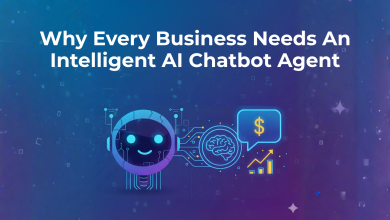Every company is racing to adopt AI, but few are seeing a true transformation of their business.
McKinsey reports 78% of enterprises now use AI, yet only 1% have truly mastered it. That’s because most treat AI as an overlay on their existing operations. They fail to make the necessary adjustments and set the foundation for AI readiness that makes the difference between AI adoption and AI-first.
AI-first is about designing systems for intelligence so that every decision drives better business outcomes. The most successful organizations, the ones that have truly become AI-first, have laid the groundwork for AI across their business.
There are thre critical choices they’ve made that give them a sustainable competitive advantage. Let’s look at these three decisions and the operational model for successful AI transformation.
Foundation first, application second
Most companies approach AI transformation backwards. They identify use cases, deploy tools, and struggle with data quality, integration challenges, and scaling problems. AI-first companies do the reverse. They build the operational foundation that makes AI applications succeed.
For example, a large pharmaceutical enterprise had accumulated a patchwork of workflows across 31 manufacturing sites, with 61 different source systems managing more than 8,700 SKUs. Trying to overlay AI tools on this fragmented infrastructure would severely limit the usefulness of any AI adoption. Instead, the company stepped back and asked a foundational question: What would unified operations look like if designed for intelligence from the start?
The answer was a central digital business platform that created a single source of truth across all sites and systems. The platform standardized processes, automated workflows, and provided end-to-end visibility into manufacturing operations before any AI applications were deployed.
The results demonstrate the power of foundation-first thinking: 30,000 hours of manual effort eliminated, $20 million reduction in cost of goods sold, and $10 million in productivity savings from eliminating redundant work. More importantly, this unified foundation now enables rapid deployment of AI applications across any site or process, because the data infrastructure is designed for intelligence.
Many companies build AI applications on weak data foundations, then wonder why they can’t scale. When data infrastructure is designed for intelligence, you can build AI applications faster, maintain them more easily, and combine them for more value.
Toolbox over tools
The second decision that defines AI-first companies is treating AI as a systematic capability rather than a collection of tools. They resist the temptation to solve individual problems with individual AI solutions, instead building platforms that enable multiple applications and create network effects.
This approach can be particularly effective for business areas with a range of challenges, like supply chains. One European chocolatier was struggling with the transition from artisanal production to factory manufacturing. Rather than deploying separate AI tools for inventory tracking, demand forecasting, and supply planning, it built what became a comprehensive intelligence platform.
The foundation was a centralized data system that could pull real-time information from ERP systems, planning tools, and inventory management applications. This single source of truth then powered multiple AI-driven capabilities like automated re-supply notifications, real-time inventory dashboards, and predictive analytics for demand planning. The result was a 20% reduction in decision cycle times and 30% faster re-supply notifications.
Each AI application became more powerful because it could access and contribute to the same underlying data ecosystem. This platform approach requires more upfront investment and longer implementation timelines than quick AI fixes. But it creates sustainable competitive advantages that are difficult for competitors to replicate.
Measure capability, not just efficiency
The biggest decision that separates AI-first companies is how they measure success. While most organizations focus on cost savings and efficiency gains, AI-first companies track KPIs like operational velocity, decision quality, and adaptive capacity, metrics that capture AI’s potential to change how business gets done.
For example, a healthcare startup built a connected health platform to manage patient care beyond hospital walls. Traditional healthcare metrics would focus on reducing administrative costs or streamlining appointment scheduling, but this organization measured something fundamentally different: its ability to deliver continuous, proactive care.
The platform integrated AI-driven predictive models that could identify patients at risk of readmission, trigger automated alerts for care teams, and provide real-time recommendations based on patient data patterns. Instead of measuring operational efficiency, this startup tracked “care velocity” — how quickly it could identify, respond to, and prevent health deterioration.
The startup achieved a 20% reduction in hospital readmissions, but the more signific Yu ant outcome was a 15% increase in analytics adoption, leading to better-informed care decisions and planning. The company onboarded five ecosystem partners in three months because its platform was designed for adaptive capacity, not just internal efficiency.
When you measure AI impact by how well it enhances human decision-making and organizational responsiveness, you discover capabilities that efficiency metrics miss entirely.
Organizations that measure capability over efficiency often find that the biggest AI wins come from applications they didn’t initially plan for.
The AI-first integration advantage
Gartner predicts that by next year, more than 80% of enterprises will deploy generative AI. As basic AI capabilities become commoditized, the competitive advantage will shift to the companies that systematically connect AI capabilities with enterprise data to drive better business decisions.
Those that build intelligence into their operational DNA can adapt faster to market changes, customer demands, and competitive threats. They’ll discover new business models that neither pure-play AI companies nor traditional enterprises can easily replicate.
Companies making these strategic choices today are writing a playbook about what will become possible when AI integration reaches maturity. They stand to move on from being in the 78% that simply use AI to the 1% that have mastered it, establishing the competitive benchmarks that will define their industries for the next decade.





